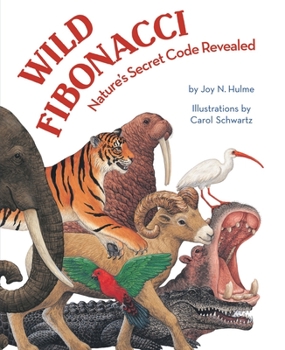Wild Fibonacci: Nature's Secret Code Revealed
Select Format
Select Condition 
Book Overview
1, 1, 2, 3, 5, 8, 13, 21, 34. . . Look carefully. Do you see the pattern? Each number above is the sum of the two numbers before it. Though most of us are unfamiliar with it, this numerical series, called the Fibonacci sequence, is part of a code that can be found everywhere in nature. Count the petals on a flower or the peas in a peapod. The numbers are all part of the Fibonacci sequence. In Wild Fibonacci, readers will discover this mysterious code in a special shape called an equiangular spiral. Why so special? It mysteriously appears in the natural world: a sundial shell curves to fit the spiral. So does a parrot's beak. . . a hawk's talon. . . a ram's horn. . . even our own human teeth Joy Hulme provides a clear and accessible introduction to the Fibonacci sequence and its presence in the animal world.
Format:Paperback
Language:English
ISBN:1582463247
ISBN13:9781582463247
Release Date:July 2010
Publisher:Tricycle Press
Length:32 Pages
Weight:0.37 lbs.
Dimensions:0.1" x 8.2" x 10.2"
Age Range:7 to 9 years
Grade Range:Grades 2 to 4
Customer Reviews
1 rating
A good choice showing children the beauty in Mathematics
Published by Thriftbooks.com User , 17 years ago
Wild Fibonacci is a beautifully illustrated book that introduces the reader to the Fibonacci sequence and how it appears in nature. For those not familiar with it, the Fibonacci sequence is 0, 1, 1, 2, 3, 5, 8, 13, 21, 34 and so on where the next number is found by adding the two before it (e.g. 2+3=5, 3+5=8). Author Joy Hulme starts with a clear and simple explanation of the concepts, giving the most commonly claimed examples of where the Fibonacci numbers appear in Nature. Then, with pictures and rhyming verse aimed at the younger audience, she cleverly integrates the formula of the sequence (e.g. 2+3=5) with pictures of animals who have body parts (tusk, tooth, talon, or tail) whose curvature appears to fit a spiral. The book is an excellent choice for parents wanting to instill a love of Mathematics in children because it shows its relevance by linking it to Nature. The rhymes stumble occasionally, but make up for it by being chock full of information for the inquisitive mind. It teaches, addition, number sequences and geometry. The major shortcoming of the book is that it tries too hard to fit animal's shapes to the curvature of the Golden Spiral, the "equiangular spiral" formed by Fibonacci squares (shown in the book). The author seems to suggest any equiangular spiral is a Golden Spiral. The sea shells shown have a spiral pattern but clearly do not grow at the same rate as the Golden Spiral, an error that will not be lost on a bright young reader. This makes it unsuitable for the high school level. (The Fibonacci numbers (and the Golden Ratio) appear in plants but not animals - with the exception of bees) Altogether, the book is a wonderful addition to a child's library.






